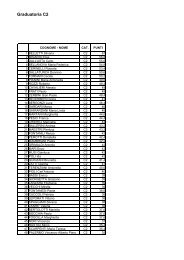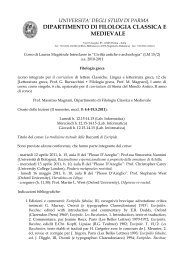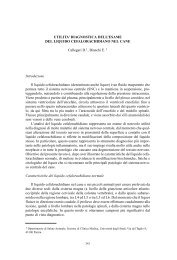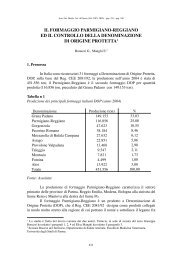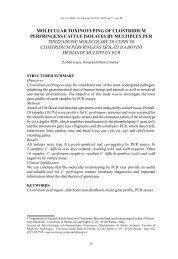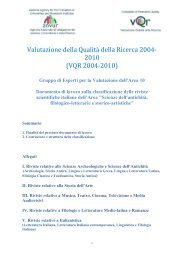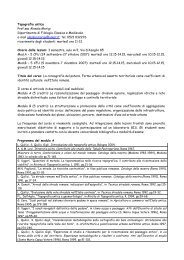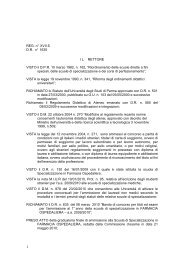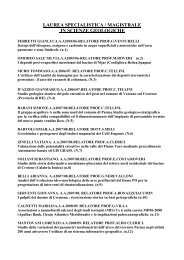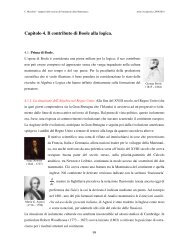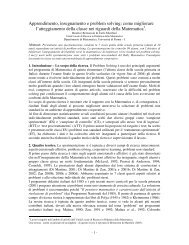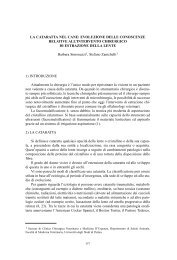Prevalence of Clostridium sPP. in diarrhoeic and healthy dogs ...
Prevalence of Clostridium sPP. in diarrhoeic and healthy dogs ...
Prevalence of Clostridium sPP. in diarrhoeic and healthy dogs ...
Create successful ePaper yourself
Turn your PDF publications into a flip-book with our unique Google optimized e-Paper software.
Ann. Fac. Medic. Vet. di Parma (Vol. XXVII, 2007) pag. 143 - pag. 156different (P= 0.023, Fisher’s test). This is <strong>in</strong> disagreement with previous reports <strong>in</strong>which significant differences were not found <strong>in</strong> the isolation rates <strong>of</strong> C. difficilebetween the 2 groups [3]. Four <strong>of</strong> ten C. difficile-positive <strong>dogs</strong> expressed enteritisafter antibiotic therapy. Probably, antibiotic adm<strong>in</strong>istration caused the overgrowth<strong>of</strong> C. difficile <strong>in</strong> <strong>in</strong>test<strong>in</strong>e <strong>of</strong> the <strong>dogs</strong>, predispos<strong>in</strong>g the animals to enteritis. Infact, a previous study has reported that the carriage rate <strong>of</strong> C. difficile <strong>and</strong> tox<strong>in</strong>s<strong>in</strong> animals <strong>in</strong>clud<strong>in</strong>g <strong>dogs</strong> that had recently received antibiotics was higher than<strong>in</strong> the nonantibiotic-treated group, although these differences were not statisticallysignificant [3]. Another study has <strong>in</strong>dicated that the presence <strong>of</strong> C. difficile <strong>in</strong> can<strong>in</strong>efeces was evident only after adm<strong>in</strong>istration <strong>of</strong> antibiotic [9]. However, results <strong>of</strong>several studies have supported the notion that antimicrobial treatment is not requiredfor C. difficile-associated disease (CDAD) development <strong>in</strong> <strong>dogs</strong> [3].S<strong>in</strong>ce we did not research the tox<strong>in</strong>s A <strong>and</strong> B (neither <strong>in</strong> vivo directly <strong>in</strong> fecesnor <strong>in</strong> vitro from the C. difficile isolates), which seem the primary virulence factors<strong>in</strong>volved <strong>in</strong> the pathogenesis <strong>of</strong> CDAD, we cannot correlate the C. difficile isolationwith dog illness. However, we performed on the 10 C. difficile isolates a duplexPCR for the revelation <strong>of</strong> tcdA <strong>and</strong> tcdB genes, encod<strong>in</strong>g for tox<strong>in</strong> A <strong>and</strong> tox<strong>in</strong> B,respectively [11]. The majority <strong>of</strong> C. difficile stra<strong>in</strong>s (6/10, 60.0%) were toxigenic(tcdA+/tcdB+) on the basis <strong>of</strong> the results <strong>of</strong> PCR assay (data not shown). The carriagerates <strong>of</strong> toxigenic isolates <strong>in</strong> <strong>diarrhoeic</strong> <strong>dogs</strong> (5/6, 83.3%) were higher than those<strong>in</strong> non-<strong>diarrhoeic</strong> <strong>dogs</strong> (1/6, 16.7%). However, this difference was not statisticallysignificant (P= 0.08, Fisher’s test).It could be <strong>in</strong>terest<strong>in</strong>g to verify if tcdA/tcdB-positive stra<strong>in</strong>s by PCR willbe able to produce the two tox<strong>in</strong>s also <strong>in</strong> vitro, because the presence <strong>of</strong> genes is notalways correlated with their expression.ConclusionsIt is particularly important to seek C. perfr<strong>in</strong>gens <strong>and</strong> C. difficile presence<strong>in</strong> can<strong>in</strong>e fecal samples. However, C. perfr<strong>in</strong>gens-associated diarrhoea <strong>in</strong> the <strong>dogs</strong>eems to be a complex disease, the pathogenesis <strong>of</strong> which is still poorly understood.Furthermore, despite various reports that have documented an association betweenthe detection <strong>of</strong> CPE <strong>and</strong> the presence <strong>of</strong> diarrhoea, it is still unclear whether or notC. perfr<strong>in</strong>gens is a primary cause <strong>of</strong> can<strong>in</strong>e diarrhoea or a secondary determ<strong>in</strong>ant.Much work still needs to be done to clarify the exact role <strong>of</strong> C. perfr<strong>in</strong>gens <strong>in</strong>can<strong>in</strong>e diarrhoea. Based on the results <strong>of</strong> several studies, the optimum diagnosticapproach for can<strong>in</strong>e C. perfr<strong>in</strong>gens-associated diarrhoea is the use <strong>of</strong> a CPE ELISA<strong>in</strong> conjunction with PCR for detection <strong>of</strong> enterotoxigenic stra<strong>in</strong>s procured aftera heat shock or alcohol shock treatment [7]. To date, different PCRs (duplex <strong>and</strong>multiplex) were evaluated for the revelation <strong>of</strong> genes encod<strong>in</strong>g for C. perfr<strong>in</strong>genstox<strong>in</strong>s (CPE, tox<strong>in</strong> α, tox<strong>in</strong> β, tox<strong>in</strong> β2, tox<strong>in</strong> ι <strong>and</strong> tox<strong>in</strong> ε) only for research purposes[2, 4]. It will be useful to evaluate these methods on our isolates for the presence <strong>of</strong>C. perfr<strong>in</strong>gens tox<strong>in</strong> genes, especially <strong>of</strong> the CPE gene. The production <strong>in</strong> vivo <strong>and</strong>/or<strong>in</strong> vitro <strong>of</strong> CPE should be also <strong>in</strong>vestigated to correlate the C. perfr<strong>in</strong>gens isolationwith diarrhoea <strong>in</strong> <strong>dogs</strong>.153



